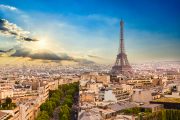It’s a myth that the Great Wall of China is visible from space. But then there are the Beijing creations that can be seen from the heavens; namely, human waste, sewage, and wastewater dumped by the rogue nation into the South China Sea.
China is well known as possibly the world’s worst polluter. It’s responsible, for example, for the presence of 28 percent of ocean-polluting plastics (more than any other four countries combined) despite having only 18.59 percent of the global population and producing just under 17 percent of the world’s plastic. Moreover, China endures smog dense enough to block sunlight from solar panels, and a majority of its water is contaminated. Then there’s Sichuan Province, where farmers must pollinate their apple orchards by hand because pesticides have killed off their entire wild bee population.
And with Beijing’s great presence in the South China Sea — which it aims to dominate and where it has built artificial islands — it’s now further gifting its pollution to the wider world. As India’s SCION reports:
Swarms of Chinese vessels have dumped human waste and wastewater for years in a disputed area of the South China Sea, causing algae blooms that have damaged coral reefs and threatened fish in an unfolding catastrophe, a US-based expert said Monday.
Satellite images over the last five years show how human waste, sewage and wastewater have accumulated and caused algae in a cluster of reefs in the Spratlys region where hundreds of Chinese fishing ships have anchored in batches, said Liz Derr, who heads Simularity Inc, a software company creating artificial intelligence technologies for satellite imagery analysis.
At least 236 ships were spotted in the atoll, internationally known as Union Banks, on June 17 alone, she said at a Philippine online news forum on China’s actions in the South China Sea, which Beijing has claimed virtually in its entirety.
Below is a SCION video on the pollution.
Beijing’s dumping is such an issue that the Philippines, which can be affected by such pollution, has dispatched its military to investigate.
All of this is driven by power-lust, of course. As Reuters reminds us, “China maintains a constant presence of coastguard and fishing boats in the South China Sea to assert its claim of sovereignty, including hundreds in the Spratly islands, where the Philippines, Brunei, Taiwan, Vietnam and Malaysia also have claims.”
Commentator Andrea Widburg adds perspective, writing that Beijing
hangs out in this region to intimidate its neighbors and assert dominance. It certainly doesn’t belong there, and all its territorial claims are fake.
Its particular aim is not just to beat up Vietnam, the Philippines, and Taiwan, but to chase out the Great White Fleet of the U.S. Navy, which at least until China started muscling in, kept the sea lanes open and enabled the smaller Asian nations of Southeast Asia to develop and grow prosperous. China’s presence already is a baleful one in the region of the South China Sea. It’s built illegal atolls. It’s had its fishing ships spy on other nations. It’s attacked boats of Vietnam and the Philippines in the past, and certainly caused trouble for the U.S. Navy.
Yet there are other villains in this story: environmentalist hypocrites. As Widburg also writes:
Are these sea thugs who don’t belong there going to be made to clean this up? Where are the Sea Shepherds? Where is Greenpeace? Given the damage, it seems like a project that could keep the environmentalist groups legitimately busy. But we don’t hear much, at least not now. Somehow, nobody wants to challenge the Chicoms, quite possibly based on all the money they give to NGOs. At least Joe Biden could speak up, yet thus far, he doesn’t. He’s too busy yoking the U.S. to the Paris climate deal instead of stopping 100% legitimate cases of bona fide pollution of the grossest sort from China.
Of course, media-, academia-, and entertainment-borne propaganda would have you believe that the big bad United States is the world’s worst polluter. “The Earth is doomed if other countries become like us” is the lament. The truth is precisely the opposite.
As I’ve often mentioned, America has more forested area now than a century ago and water and air cleaner than they were 60 years back. This reflects the truth that there are two prerequisites for environmental health: freedom, in the sense of being able to choose (and reject) your leaders; and prosperity.
Why Freedom?
Autocrats — especially the type of (sometimes sociopathic) people rising to power in despotic regimes — generally have no compunction about destroying man or nature if it serves their ends. And when there are no media or public-interest watchdogs to sound an alarm, no governments or private entities to sue, and no politicians to hold accountable via elections because there’s no freedom, there’s nothing to stop them. Perhaps we can say: Absolute power pollutes absolutely.
Why Prosperity?
Economic freedom ultimately breeds wealth, and wealth breeds environmental health. For when “there’s food on the table, there are many problems; when there’s no food on the table, there’s only one problem,” the Chinese proverb goes. Starving people aren’t worried about burning jungle to farm or killing an endangered animal; they’re endangered themselves. As the “environmental Kuznets Curve” informs, wrote The Stream in 2015, “the wealthier a country is, the more its citizens can afford to pay for, and are willing to pay for, clean air and water.”
So the reality is that if we want a healthy global environment, other nations must become like us.
Also note, America-phobes, this is yet another argument for Western hegemony. If you want a clean world, it must be dominated by free and prosperous nations. At this moment, at least, that’s the West.



